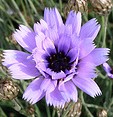 Cupid’s dart is a herbaceous perennial belonging to the aster family,Asteraceae, that also includes daisy, yarrow and lettuce. It is native to Mediterranean Europe and northern Africa where it grows in meadows and wasteland. Growing 24-36″ tall, the plant has narrow gray-green leaves 8-10″ long that are hairy, grass-like and form basal clumps that give rise to leafless wiry stems bearing tightly closed silvery buds that suddenly open to blue to lavender flowers from mid-summer to fall. The flowers are 2″ in diameter and are subtended by overlapping papery bracts. Cupid’s dart is an old fashioned plant and a good choice for a cottage garden where it looks best planted en mass. It is short-lived under the best conditions, and does poorly in areas with high heat and humidity. Annual division extends the life of the plant. Both fresh and dried flowers are good in arrangements. Cultivars are available varying most significantly in color. The common name, Cupid’s dart, comes from the plant’s use by the ancient Greeks in a love potion. The genus name, Catananche, is the Greek word meaning compulsion. The specific epithet, caerulea, is the Latin word for dark blue and refers to the flower color of the species.
Cupid’s dart is a herbaceous perennial belonging to the aster family,Asteraceae, that also includes daisy, yarrow and lettuce. It is native to Mediterranean Europe and northern Africa where it grows in meadows and wasteland. Growing 24-36″ tall, the plant has narrow gray-green leaves 8-10″ long that are hairy, grass-like and form basal clumps that give rise to leafless wiry stems bearing tightly closed silvery buds that suddenly open to blue to lavender flowers from mid-summer to fall. The flowers are 2″ in diameter and are subtended by overlapping papery bracts. Cupid’s dart is an old fashioned plant and a good choice for a cottage garden where it looks best planted en mass. It is short-lived under the best conditions, and does poorly in areas with high heat and humidity. Annual division extends the life of the plant. Both fresh and dried flowers are good in arrangements. Cultivars are available varying most significantly in color. The common name, Cupid’s dart, comes from the plant’s use by the ancient Greeks in a love potion. The genus name, Catananche, is the Greek word meaning compulsion. The specific epithet, caerulea, is the Latin word for dark blue and refers to the flower color of the species.
Type: Herbaceous perennial
Bloom: Lavender to blue flowers 2 inches in diameter from mid-summer to autumn
Size: 24-36” H x 12” W
Light: Full sun
Soil: Average, medium moist, well-drained
Hardiness: Zones 4-8
Care: Divide annually to maintain vigor.
Pests and Diseases: Generally pest free but susceptible to powdery mildew
Propagation: Seed, division
Companion plants: Yarrow (Achillea), baby’s breath, Purple cone flower (Echinacea), Gaura, Lamb’s ear, Russian sage (Perovskia), black-eyed Susan (Rudbeckia), Shasta daisy, and ornamental grasses
Outstanding Selections:
‘Alba’ (white)
‘Blue Giant’ (cornflower blue)
‘Bicolor’ (white with deep blue center)
‘Major’ (deep lavender)
‘Perry’s White’ (white).